Updated 12/28/2025
MISSION
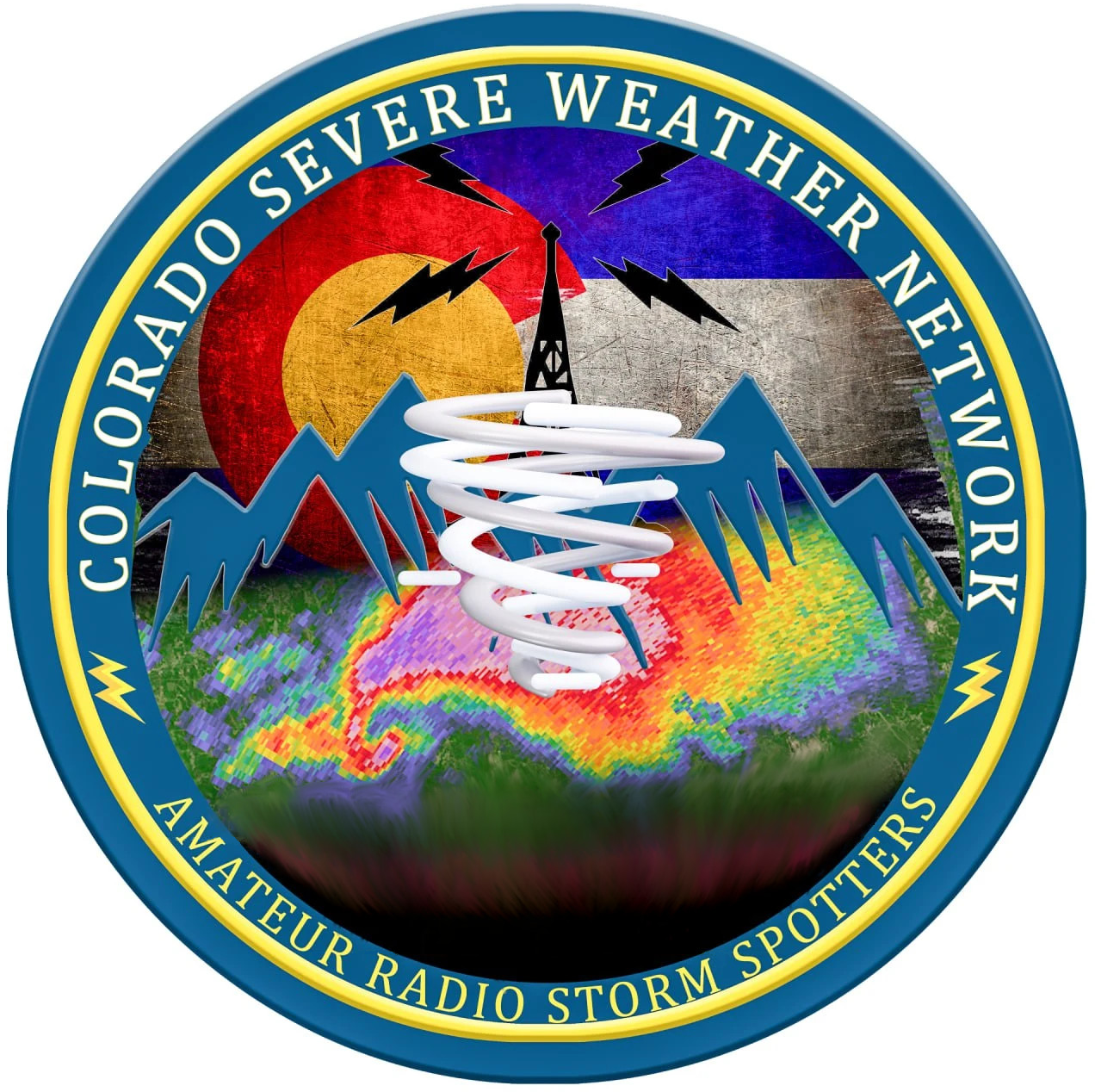 To provide reliable and prompt delivery of vital ground truth from SKYWARN® storm spotters to the National Weather Service, in accordance with its severe criteria and in support of its mission to protect lives and property during severe weather. To generate an interest in—and understanding of—weather phenomena; and to promote NWS SKYWARN® training and participation within an all-inclusive environment. To ensure that amateur radio plays a vital and strategic role within the SKYWARN® program. ©
To provide reliable and prompt delivery of vital ground truth from SKYWARN® storm spotters to the National Weather Service, in accordance with its severe criteria and in support of its mission to protect lives and property during severe weather. To generate an interest in—and understanding of—weather phenomena; and to promote NWS SKYWARN® training and participation within an all-inclusive environment. To ensure that amateur radio plays a vital and strategic role within the SKYWARN® program. ©
WHO WE ARE
The Colorado Severe Weather Network (CSWN) is a SKYWARN® Trained Amateur Radio Team (STAR Team) bringing unique knowledge, support and communications capability to the NWS and the public. Our Core Values are D.I.R.E.C.T to our Mission Statement and community involvement, that is: Dedication, Integrity, Respect, Education, Continuous Improvement, Teamwork. We are Core Partners with these NWS Warnings Forecast Offices: Grand Junction CO, Denver/Boulder CO, Goodland KS, Pueblo CO, Cheyenne WY, Salt Lake City UT.
CSWN Team Leaders
- Gary Maier NC2WX—Colorado Severe Weather Network Coordinator
- Bill ‘Bucky’ Buckwalter W0SUN—Communications/IT, Weather Ops Support, Consultant
- Jon Poindexter W5ALC—Technical Systems Specialist
- Jay Wuensch AI7OF—Tech Support, Consultant, Alternate Logger
- John Julian W7JPJ—Telegram Administration, Primary Logger
- Terry Koelling AD0A—Weather Information Room/Telegram
- Steve Worley KD0ZA—Regional Road Conditions/Telegram
- Abraham Sandy KF0MLS—Director of Public Relations/Social Media
- Kathleen ‘Kat’ Hickman W0KPH—Consultant, Alternate Logger
- CSWN Contact: CO.SEVERE.WX@gmail.com
WHAT IS SKYWARN®?
To obtain critical weather information, the National Weather Service (NWS) established SKYWARN® with partner organizations. SKYWARN® is a citizen volunteer program with between 350,000 and 400,000 trained severe weather spotters. SKYWARN® storm spotters are citizens who form the nation’s first line of defense against severe weather. These volunteers help keep their local communities safe by providing timely and accurate reports of severe weather to the National Weather Service. Although SKYWARN® spotters provide essential information for all types of weather hazards, the main responsibility of a SKYWARN® spotter is to identify and describe severe local storms. The information provided by SKYWARN® spotters, coupled with Doppler radar technology, improved satellite and other data, has enabled NWS to issue more timely and accurate warnings for tornadoes, severe thunderstorms and flash floods. Storm spotters play a critical role because they can see things that radar and other technological tools cannot, and this ground truth is critical in helping the NWS perform our primary mission, to save lives and property. Adapted from NOAA/NWS SKYWARN®, US Department of Commerce
The SkyHubLink system is excited to host the Weather Outlook Net, weekdays at 1pm MT. This Outlook focuses on eastern UT, Colorado, eastern Wyoming, and the Nebraska Panhandle—within the auspices of the NWS offices with whom we are Core Partners (see map & link below). The net provides detailed information to SKYWARN® storm spotters within our region.
During especially active weather, we air critical NWS updates between 8-10am, at ~4pm MT, and at any other time when the public may be under severe threat.
The CO Severe Weather Room (Reflector XLX303a) is active when our region is under threat. The Colorado Severe Weather Network (CSWN) segregates repeaters within an outbreak area into the CO Severe Weather Room. The Room supports dialog between Net Control, Storm Spotters, and the public. Timely NWS severe information is provided, along with storm evolution, tracks, etc. SKYWARN® spotters call in severe reports (and photos) to Net Control and those, in turn, are immediately relayed to the appropriate NWS office via a secure NOAA platform.
To access the CO Severe Weather Room at Reflector xlx303a (when your repeater isn’t connected):
EchoLink Node 155536 NC2WX-L
Droid-STAR XRF/DCS303A
Brandmeister/DMR 31083
Allstar Node 485322 (Wx Hub) or 289800
Wires-X Room 65045
YSF 30300 (switch to module A, DGID 10)
To merely listen to the CO Severe Rm go to https://hose.brandmeister.network/?subscribe=31083
The CSWN provides three Telegram (free signup) rooms to serve you:
SkyHubLink Weather Information, where you can quickly view the day’s weather outlooks for our entire S-Central Rockies/High Plains region (NWS Grand Junction, Denver/Boulder, Goodland, Pueblo, and Cheyenne). Link is https://t.me/ColoWxNet. On weekday mornings, Terry AD0A hosts this room.
Colorado Severe Weather Network, this room is open to everyone and any weather/climate-related chat, weather science and education. This room is also used for visual aids during the Weather Outlook Net at 1pm MT and is a platform for checking in to that net. During severe weather outbreaks, the room is utilized for SKYWARN® severe storm reporting and photos which are relayed to the appropriate NWS office. Link is https://t.me/+_WFpWF8-vzI0NmYx . John W7JPJ is Primary Logger during the Outlook Net and Gary NC2WX is usually Net Control during severe weather.
[NEW!] CO-WY Road Conditions, during winter storm outbreaks, adverse & hazardous travel information is posted between 0700-0800 and again at 1600-1700. In the case of major thoroughfares (Interstates & heavily traveled Primary Highways), crucial updates will be posted as they arise. For the benefit of others, travelers may POST adverse/hazardous road conditions you encounter throughout our Central Rockies/High Plains Region. Also, hear announcements in the CO Severe Weather Room at Reflector XLX303A at 0745, 1600, and whenever else needed. Link to the Telegram room is https://t.me/+lKWsGPdSs3NkMTAx. Steve KD0ZA hosts this room as he monitors CDOT and WYDOT.
PROGRESS CONTINUES WITH MORE EXCITING THINGS TO COME!
- We are seeking operators with a general weather knowledge along with NWS SKYWARN® training to jump in as Net Control for affected areas during severe outbreaks. Retirees are best. In particular, we need a SKYWARN® leader for the NWS Cheyenne area.
- Recently implemented is the Colorado-Wyoming Road Conditions service. This addresses Interstates, heavily traveled Primary highways, and other important roadways.
- With the NEW southeastern Colorado repeaters, weather coverage has been added from La Junta to the Walsenburg area, Weston, and the San Luis Valley!
- Just added is our Team Leader Email address: CO.SEVERE.WX@gmail.com!
- In the near-future, we will implement Ham.Live as our primary SKYWARN® reporting platform. Severe Threshold reports will be migrated from the CO Reg Wx Chatroom to Ham.Live. It has these benefits: Net Control can see you sign in and keep track of you & your safety; storm reports and photos can be easily posted by spotters, while Net Control can quickly relay them to the NWS.
- Occasional evening nets covering storms & their evolution, SKYWARN® storm spotting, how to report, etc.
For more information or to volunteer your talents, contact:
CSWN Team Leaders: CO.SEVERE.WX@gmail.com
Gary NC2WX, Severe Weather Network Coordinator, at weather.nc2wx@gmail.com
Jack KEØVH, SkyHubLink Administrator, at ke0vh@outlook.com
We experience many types of extreme weather: tornadoes, hail, microbursts, damaging winds, flash and areal flooding, wildfires, droughts, heatwaves, and blizzards. You’re most likely to hear activity during the summer severe storm season. However, significant or large-scale winter storms also warrant net activation. SKYWARN activations are intended to collect, analyze, and traffic severe reports to your Weather Service office as efficiently and quickly as possible. Real-time National Weather Service and NOAA info (warnings & extreme weather) is aired in the Colorado Severe Weather Room and is occasionally aired across the SkyHubLink system when necessary. Also, we strive to further your understanding of severe phenomena.
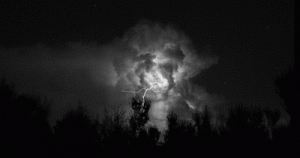
Colorado Severe Weather Network Coverage Area
Colorado North/Northeast (NWS Boulder)
Colorado eastern border Counties, NW Kansas, SW Nebraska (NWS Goodland)
Colorado South/Southeast (NWS Pueblo)
Colorado Western Slope, eastern UT border Counties (NWS Grand Junction)
Wyoming East/South, western Panhandle Nebr. (NWS Cheyenne)
Click for your NWS region in the USA and Territories: https://www.weather.gov/gsp/nwsCWAMap

When the Colorado Severe Weather Room is activated, announcements to that effect will go out on SkyHubLink, on the Telegram platform ‘CO Regional Weather Chat’ and, eventually, on Ham.Live.
DO NOT ASSUME OTHERS HAVE ALREADY REPORTED THE SEVERE WEATHER YOU ARE SEEING! DO REPORT IT!
The 5 NWS offices that we serve rely on us to provide them with accurate, timely Ground Truth, which bolsters their high-tech scientific equipment. Our reports aid them in launching Advisories and Warnings, thus keeping the public informed and safe.
PLEASE participate regularly in the CO Severe Wx Room via the modes listed above.
_______end of updates______________end of updates______________end of updates_______end of updates_______
Severe Room Activation types—Informational, Informal, Formal Net
Every effort is made to avoid interfering with conversations & nets on the SkyHubLink.
You may hear periodic NWS warning or advisory announcements. This does not mean the system is in a net mode. If an informational, informal, or formal net is activated, it will usually be within a Severe Weather Room and announced periodically. If you aren’t sure, simply call out and ask.
- Informational, no net is yet activated. NWS announcements air as needed and there may be weather conversations. The SkyHubLink and/or the Severe Weather Room operate normally. Upon Severe Weather Room activation, the Severe Weather Watch Network may be set to an informal or a directed net.
- Informal Nets occur in a Severe Weather Room and are most common. A Net Coordinator will be present. The Room is open for all weather use and station-to-station traffic. We ask that you keep transmissions shorter. Severe announcements take place, along with heads-ups on developments, and periodic conversations about events. Severe reports may be trafficked. Leave at least 5-7 seconds between transmissions for priority traffic to break in. End each transmission with your callsign.
- Formal, Directed Nets are used during significant, widespread severe weather. During directed nets, all communications must be passed through the Net Control Station. Traffic will usually be limited to priority and severe reports, severe observations, and Warnings information.
Always adhere to guidance from the Network Coordinator or NC. All amateur radio operators across Colorado and Wyoming are encouraged to participate. Ask questions, report observations, and further your understanding of severe weather.
Severe Weather Net Operating Procedure
When checking in to a net, please do the following:
- Turn on either APRS or Spotter Network beaconing. Spotter Network probably works best. (No worries if you don’t have these).
- Clearly state your callsign twice.
- NWS Spotter Number if you have one.
- Location—current and anticipated.
- Clear every transmission with your callsign.
- Allow 5-7 seconds between transmissions for priority to break-in.
- Advise NC of all location changes.
- NC will frequently address you by your Suffix, usually phonetically.
- ALWAYS advise NC when you are checking out of the net, arriving home, or QRT!
KEEP CALM, BREATHE DEEP, WAIT 30-60 SECONDS, WATCH
Reporting Criteria
Net Control is your guide as to what/what not to report. This depends on how deep we are into storm evolution and scope, magnitude, and the amount of traffic in the Severe Weather Room. Usually, reports are limited to NWS Severe Thresholds.
YOUR REPORT MUST INCLUDE:
- Event ‘Name’ (e.g., Hail, Rotating Wall Cloud, Funnel Cloud, Straight-line Wind)
- Current location
- Event Location, (advise if estimated) e.g., street/road intersections, mile markers, miles & direction from a known locality
- County in which event is located—important
- Description—brief but concise, lose adjectives whenever possible
- Clear with your callsign and wait to confirm the readback from NC.
Sometimes, criteria may be modified by NWS based on need. NWS may want hail reports to as small as 1/4” including fall field depth, instead of the usual size of 0.75” and larger.
Listen carefully to Net Control for guidance. Too many non-severe reports can unnecessarily overload communications in a SkyHubLink Severe Weather Room.
What to Report to Severe Weather Net Control
Gather your thoughts. When in doubt, wait and observe for another few moments
- Tornadoes, landspouts, gustnadoes—confirm that formation is on the ground
- Funnel cloud/condensation funnel, look carefully at surface for dust/debris
- Wall Clouds may be very slowly rotating. Should be attached to cloud base in or near the clear slot, away from rain shaft. Scud—ragged clouds detached from the storm base—are tricky. If they’re very near or under a wall cloud, then watch closely and we need to discuss because they may be part of a somewhat invisible, possibly weak, rotation.
- Micro & Macro (large) downbursts, look for rain/dust spreading away at surface
- Damaging straight-line winds blowing down trees and powerlines, damaging buildings (see wind speed estimation below). Handheld anemometer measurements are bes.
- Hail, usually 0.75” largest side (1”+ is severe) (see hail reporting graphic below)
- Rain Rates, 1”/hr urban, 1.5”/hr rural
- Flooding of rivers, creeks, drainages, homes, buildings, roadways
In the case of roadway flooding that is a danger to traffic, first call 911. Then, report the heads-up to Net Control, clearly stating that you have reported to 911. NC will relay the heads-up to NWS. Some NWS offices want road flooding reported only to emergency management which, in turn, relays the report to them.
- Whiteout snow conditions with visibility less than 0.5 miles
Participants are encouraged to share reports of the severity they’re observing. However, exclude reports such as ‘light rain’ or ‘it’s clear here’ unless called for. Always be ready to give an estimate of direction and distance of the event from your location. If you’re uncertain of the severity, please state that to Net Control.
What to Report to 911
- Traffic accidents due to severe weather
- Dangerous road conditions due to severe weather, including flooding. Call 911 and report, asking them to relay to the NWS. THEN, call a heads-up to Net Control, clearly stating that you have already reported this to 911. Net Control will relay to NWS to make certain they got the message.
- Structural damage due to severe weather
- Downed power lines and poles anywhere
HELPFUL DASHBOARDS for monitoring connections at the CO Severe Weather Room—
Weather Hub (AllStar Repeaters): https://kg0sky.duckdns.org/allmon2/link.php?nodes=485322
SkyHubLink Allstar (Primary): https://kg0sky.duckdns.org/allmon2/link.php?nodes=46079
CO Severe Wx Rm AllStar: http://status.kf0lpt.com:8085/supermon/link.php?nodes=289800.289802
Colorado Digital Multiprotocol Reflector (all modules): http://coloradodigital.duckdns.org/
Click here for cloud identification chart & descriptions:
https://www.weather.gov/jetstream/cloudchart#myModalh4
Click here for graphics on storm identification, reporting, and safety:
http://www.k3r7wx.com/wxsafety.html
(Even though it’s from Louisiana, nearly all is pertinent to our area & elsewhere. Have a close look at the Thunderstorm Risk Categories)
Click for concise Spotter Field Guide (72 pg. PDF produced by NWS Norman, OK)
https://www.weather.gov/media/oun/spottertraining/basicspotterguide.pdf
General Severe Warnings Thresholds
- Severe Thunderstorm: hail 1” or greater with winds 58mph or greater.
- Heavy rain: reportable at 1” per hour or greater. Often coupled with thunderstorm parameters above to define severe.
- Tornado: Tightly rotating column of air attached to a thunderstorm cloud AND in contact with the ground.
- Funnel Cloud: Tightly rotating column of air attached to a thunderstorm but NOT in contact with ground. Requires careful observation of surface beneath, since may be invisible near surface. Normally prompts Warning.
- Flash Flood: Short duration (usually <6hrs), sudden, intense flooding.
- Flood or Areal Flood: Longer (often many hrs), more gradual flooding after excessive rainfall or snowmelt; usually prolonged river/stream flooding.
- Blizzard: winds sustained 35+mph, or frequent gusts to 35+; blowing snow and visibility <1/4mi, all for 3 or more hours.
- Snow Squall: Visibility 1/4mi or less with sub-freezing road temperatures. Or flash-freezing with significant reduction in visibility from falling and/or blowing snow.
- Ice Storm: any freezing rain event.
- Red Flag: Critical fuels paired with winds (sustained or gusting) >25mph with humidity <15%. Or critical fuels paired with widely scattered dry thunderstorms. Often initiates a Dry Thunderstorm Fire Risk advisory.
- Dust Storm: visibility <1/4mi for at least 1hr along with winds (sustained or gusting) 25+mph. May be either localized or widespread.
- High Straight-line Wind: sustained at 50+mph for 1+ hrs, or gusts at 58+mph for any duration.
Wind Speed Estimation
Less than 1 mph – Smoke rises vertically
1-3 mph – Light Air Movement – Smoke drift indicates wind direction, still wind vanes
4-7 mph – Light Breeze – Wind felt on face, leaves rustle, vanes begin to move
8-12 mph – Leaves and small twigs constantly moving, light flags extended
13-18 mph – Moderate Breeze – Dust, leaves, loose paper lifted, small branches move
19-24 mph – Fresh Breeze – Small trees in leaf begin to sway
25-31 mph – Strong Breeze – Larger tree branches moving, whistling in wires
32-38 mph – Near Gale – Whole trees moving, resistance felt walking against wind
39-46 mph – Gale – Twigs breaking off trees, generally impedes progress
47-54 mph – Strong Gale – Slight structural damage; shingles may lift off roofs
55-63 mph – Storm force – Trees broken or uprooted, considerable structural damage
58+ mph (60 knots) is severe threshold
64-72+ mph – Violent storm force – Widespread tree and structural damage
Hail—severe 1”, reportable at ¾” (sometimes adjusted downward)
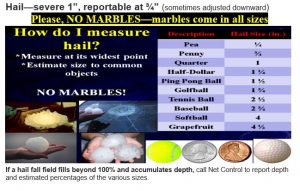
Snow Measurement
Some things you should keep in mind when measuring snow:
- NWS appreciates liquid equivalent in addition to accumulated depth.
-
- Can easily be accomplished with a 4” diameter, 14” tall rain/snow gauge.
- Available from a variety of sources including CoCoRaHS.org.
- Measure snow depth in a location where scouring or drifting has not occurred
- Sheltered areas close to buildings, near or under trees should be avoided
- Make sure you’re measuring on a flat surface if you don’t have a snow board
- Things like picnic tables and decks work well. If you don’t have that option, measure on a flat portion of your yard away from buildings
- Take 5 measurements, add them, and divide by 5 to get an accurate average
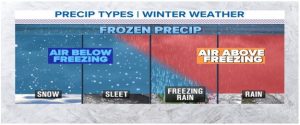
Train and become an NWS Certified Weather SpotterIT’S EASY and FUN! NWS always has a need for additional spottersThe NWS spotter program is a nationwide network of volunteers trained by the NWS to provide timely and accurate reports of severe or significant weather events.Storm spotters provide vital ground truth to the National Weather Service, delivering necessary eyes-on observations that supplement their high-tech instrumentation. Trained spotter reports are essential to NWS’ real-time decision making for Warnings, Watches, Special Statements, and even short-term forecasts.
See also https://www.weather.gov/SKYWARN Your local Weather Service office conducts spotter training each spring, both in-person and virtual. Announcements are often at the top of each NWS homepage or under ‘Local Programs.’ Training schedules are promoted during the SkyHubLink 1pm Weather Outlook Net. During the off-season, virtual training is always available. (See the “Further Education tab for details.)
For more information, or to volunteer for the SkyHubLink Severe Weather Watch Network, contact Gary NC2WX at weather.nc2wx@gmail.com.We’re also looking for Net Control Operators during severe outbreaks to help handle the four CO NWS regions and the Cheyenne NWS region.
(For reference The old MetEd site’s link is now dead. https://www.meted.ucar.edu/index.php
the new link to sign up is
https://learn.meted.ucar.edu/#/signup-form
and after signup one can login with link
https://learn.meted.ucar.edu/#/login
- Handy LinksNOAA USA Interactive Hazards Viewer with Radar:https://www.wrh.noaa.gov/map/?&zoom=7&scroll_zoom=true¢er=39.39375459224348,-111.126708984375&basemap=OpenStreetMap&boundaries=true,false,false&hazard=true&hazard_type=hi-all&hazard_opacity=60Nationwide NWS Alerts Map: https://www.weather.gov/NWS Graphical Forecasts Map: https://digital.mdl.nws.noaa.gov/NWS IDSS Point Forecast Map: https://www.weather.gov/forecastpointsStorm Prediction Center Page: https://www.spc.noaa.gov/Storm Prediction Center Convective Outlook Maps: https://www.spc.noaa.gov/products/outlook/Weather Prediction Center: https://www.wpc.ncep.noaa.gov/index.shtml#page=ovwGOES East Satellite Image Viewer: https://www.star.nesdis.noaa.gov/GOES/conus.php?sat=G16VENTUsky Outlook &Modeling site: https://www.ventusky.com/?p=37.3;-91.3;4&l=temperature-2m&t=20220203/0200Windy.com Outlook & Modeling site: https://www.windy.com/?38.828,-106.100,7Hello, Storm Spotters! Here’s a link to EVERYTHING ABOUT THUNDERSTORMS and DEVELOPMENT. It is very helpful toward understanding what is said during severe outbreaks, and we’ll be discussing this during upcoming Weather Outlook nets.https://www.weather.gov/source/zhu/ZHU_Training_Page/thunderstorm_stuff/Thunderstorms/thunderstorms.htmUSGS Interactive Earthquake Map:https://earthquake.usgs.gov/earthquakes/map/?extent=32.19421,-113.33496&extent=43.94537,-93.64746&magnitude=all&showUSFaults=true&baseLayer=terrain&settings=trueUSA Astronomical Data Map & More: https://www.timeanddate.com/astronomy/usaIowa State (IEM) Weather Information and Data Feeds: https://mesonet.agron.iastate.edu/Allison House Wx Data Feeds (subscription): https://www.allisonhouse.com/Radar Status Nationwide: https://radar2pub.ncep.noaa.gov/Interactive NWS Mobile Alerting (limited access): https://inws.ncep.noaa.gov/Community Collaborative Rain, Hail & Snow Network: https://www.cocorahs.org/Weather Terms Glossary: https://www.weather.gov/oun/spotterglossaryWatch, Warning, Advisory Thresholds/Definitions:https://www.weather.gov/lwx/warningsdefined
GARY, NC2WX
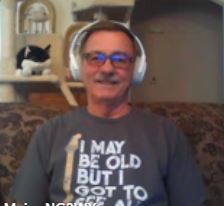
The SkyHubLink Severe Weather Watch Network had its first net activation during the weekend of March 13-14, 2021, during a massive and dangerous winter storm. Thanks to Matt KØLWC and Daryl W3ORR for their great job in handling the NET and for initiating an unstoppable, ever-growing program!


Education Opportunities
NWS Norman, OK—numerous Skywarn Spotter videos, field guides, FAQs, and much more: https://www.weather.gov/oun/skywarn
Comet MetEd weather education courses: https://www.meted.ucar.edu/index.php